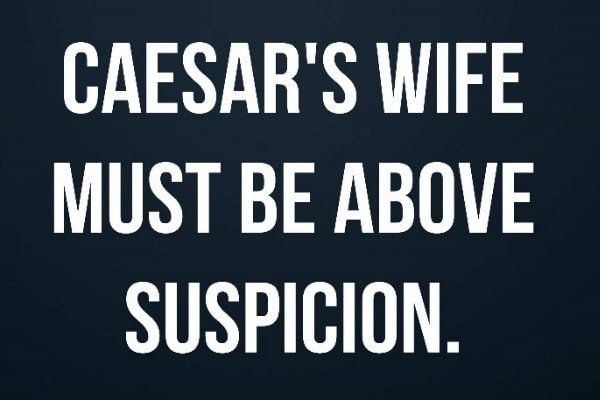In leadership conversations across the boardrooms and virtual meeting rooms we’ve facilitated over the years, one theme consistently emerges: credibility is not optional. It is essential.
The old Roman adage, “Caesar’s wife must be above suspicion,” may come from ancient history, but its wisdom is profoundly modern. It underscores an inconvenient truth about leadership: your actions carry more weight than your words, and trust, once lost, is rarely regained.
In our experience working with leaders across industries, we’ve noticed that leadership isn’t just about vision, strategy, or even results. It’s about who you are when no one is watching – and especially when everyone is.
Leadership Is a Mirror
Table of Contents
Whether we realise it or not, leaders serve as the behavioural template for their teams. Every decision, every comment, and every habit becomes part of the unspoken rulebook that others begin to follow. As facilitators of leadership journeys, we’ve seen teams take on the traits of their leaders – the good and the not-so-good.
If a leader consistently shows up late, people start believing that punctuality isn’t a priority. If a leader fails to listen during meetings, soon the team mirrors that same disinterest. And if a leader speaks about values but behaves otherwise, the cultural dissonance that follows isn’t just noticeable – it’s toxic.
In our workshops, we often say: “You teach what you allow, and you become what you tolerate.” Leadership by example is the quiet force that shapes team dynamics, builds (or breaks) psychological safety, and either amplifies or dilutes organisational culture.
Related Reading: Why Leadership is a Challenge?
The Daily Debits of Credibility
We’ve noticed that leadership credibility isn’t lost in one fell swoop. It is eroded slowly – through small, repeated lapses:
- Showing up late to meetings
- Not responding to messages or emails
- Making promises and not keeping them
- Avoiding difficult conversations
- Prioritising tasks over people
- Delegating blame but hoarding praise
These micro-moments become macro-signals. They send messages to your team about what’s truly important – regardless of what your posters or values decks might say.
And make no mistake: your team is watching. Perhaps not always consciously, but they are observing and interpreting. We’ve seen in our leadership simulations how quickly trust erodes when the leader isn’t walking the talk.
Related Reading: Why Leadership Development Programs Fail?
Why Audio-Video Alignment Matters
We often use the phrase “align your audio and video” in our programs. It’s a simple metaphor, but it carries immense weight.
When leaders align what they say with what they do, they generate clarity. And clarity breeds confidence. But when there’s a disconnect – when your words and your actions don’t match – confusion seeps in. And confusion is the enemy of performance.
We’ve seen it repeatedly: teams that trust their leaders tend to take risks, innovate, speak up, and hold each other accountable. Teams that don’t? They comply. They stay quiet. They play safe.
Related Reading: Why Leaders Need To Stand By Their Words?
The Leader’s Credibility Audit
Here are a few reflective questions we encourage leaders to ask themselves:
- Do I consistently follow through on what I say I will do?
- Do I acknowledge my team’s efforts regularly and sincerely?
- Do I model the behaviours I expect from others?
- Do I show up fully present in conversations, or am I distracted?
- Do I create an environment where feedback flows both ways?
These aren’t checklist items – they are habits. And over time, they become identity.
Related Reading: 7 Distinct Leadership Styles
The Cost of Inconsistency
In our experience, nothing breaks a team faster than inconsistent leadership. People begin to second-guess intentions, guard their inputs, and withhold their best efforts. It creates a culture of uncertainty – one where psychological safety withers.
We’ve also observed that leaders who fail to model the expected behaviours inadvertently make it harder for HR and L&D teams. Because no matter how good the training content is, when employees go back and see their leaders behaving contrary to what was taught – the training fails. The message gets invalidated.
Related Reading: From Boardrooms to Backlash: Tales of Leadership Gone Wrong
Culture Cascades Down
An organisation’s culture is not built in conference rooms; it is built in the everyday behaviours of its leaders. And culture cascades – not by what’s written on posters, but by what leaders demonstrate daily.
In our work with organisations that have undergone cultural transformation, one key insight stands out: real change begins when leaders go first. When they model humility, integrity, and vulnerability, others follow. When they avoid accountability, cut corners, or ignore issues – others follow that too.
Related Reading: How Leaders Emerge
Leading with Intent
So, what does leading by example look like in the real world? Here are a few examples from our experience:
- A senior leader who shares their own development plan with the team to show that learning never stops
- A manager who apologises publicly for an error in judgment, reinforcing that mistakes can be acknowledged
- A CXO who actively participates in feedback sessions, modelling openness to criticism
- A leader who switches off their phone during meetings, setting the tone for presence and attention
These aren’t grand gestures. But their impact is profound.
Related Reading: Leadership Insights : How To Inspire Your Team
Final Thoughts
Leadership isn’t about perfection. But it is about consistency. And credibility. And owning your role as a role model.
As someone who’s been on both sides of the leadership equation – as a team member and now as a facilitator to leaders – I can say this with certainty: people don’t need flawless leaders. They need authentic ones.
They need leaders who show up. Who listen. Who follow through. Who model the values the organisation claims to stand for.
Because at the end of the day, leadership isn’t a title. It’s an example. One that’s being followed.
What kind of example are you setting today?










